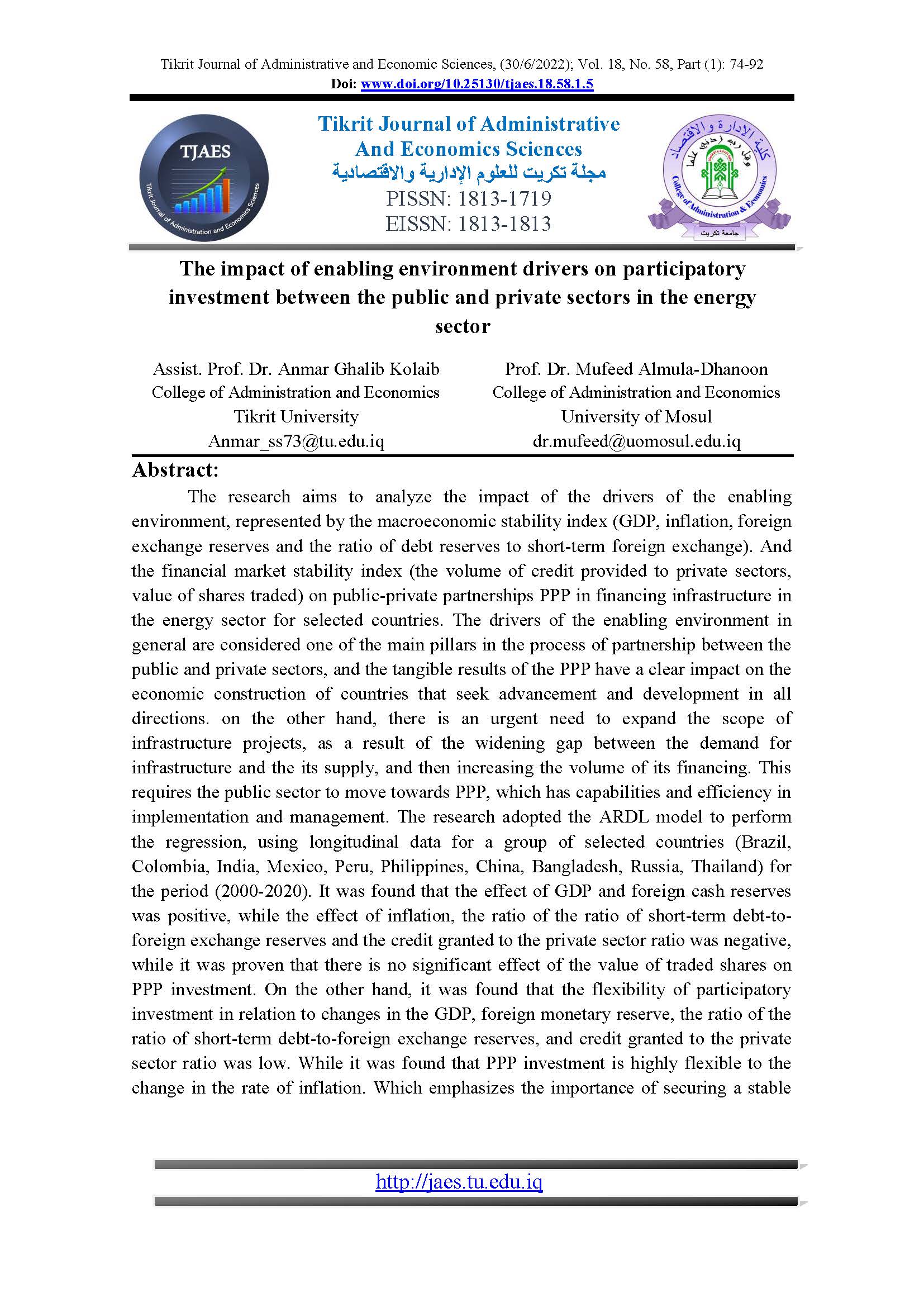The impact of enabling environment drivers on participatory investment between the public and private sectors in the energy sector
Main Article Content
Abstract
The research aims to analyze the impact of the drivers of the enabling environment, represented by the macroeconomic stability index (GDP, inflation, foreign exchange reserves and the ratio of debt reserves to short-term foreign exchange). And the financial market stability index (the volume of credit provided to private sectors, value of shares traded) on public-private partnerships PPP in financing infrastructure in the energy sector for selected countries. The drivers of the enabling environment in general are considered one of the main pillars in the process of partnership between the public and private sectors, and the tangible results of the PPP have a clear impact on the economic construction of countries that seek advancement and development in all directions. on the other hand, there is an urgent need to expand the scope of infrastructure projects, as a result of the widening gap between the demand for infrastructure and the its supply, and then increasing the volume of its financing. This requires the public sector to move towards PPP, which has capabilities and efficiency in implementation and management. The research adopted the ARDL model to perform the regression, using longitudinal data for a group of selected countries (Brazil, Colombia, India, Mexico, Peru, Philippines, China, Bangladesh, Russia, Thailand) for the period (2000-2020). It was found that the effect of GDP and foreign cash reserves was positive, while the effect of inflation, the ratio of the ratio of short-term debt-to-foreign exchange reserves and the credit granted to the private sector ratio was negative, while it was proven that there is no significant effect of the value of traded shares on PPP investment. On the other hand, it was found that the flexibility of participatory investment in relation to changes in the GDP, foreign monetary reserve, the ratio of the ratio of short-term debt-to-foreign exchange reserves, and credit granted to the private sector ratio was low. While it was found that PPP investment is highly flexible to the change in the rate of inflation. Which emphasizes the importance of securing a stable macroeconomic environment for the purpose of stimulating PPP investment in the energy sector.
Downloads
Article Details
References
اولاً. المصادر العربية:
ابو سريع، محمد، (2014)، دور الشراكة بين القطاعين العام والخاص في توفير خدمات الطاقة العام لدراسة تطبيقية على الحالة المصرية، اطروحة دكتوراه غير منشورة، كلية الاقتصاد والعلوم السياسية، جامعة القاهرة، القاهرة.
ثانياً. المصادر الأجنبية:
Ahmad, Salman, Shahnawaz Khan, Shah Wali Khan, (2016), Developing Infrastructure through Public Private Partnerships; Understanding the Elements of the Enabling Environment, Business & Economic Review: Vol. 8, Issue 1: 2016 pp. 19-34.
Akhtar, et al., (2018), Mobilizing Finance for Sustained, Inclusive and Sustainable Economic Growth, United Nations Publication, ESCAP. https://www.unescap.org/sites/default/files/Mobilizing%20Finance_0.pdf
Babatunde, S, (2015), Developing Public Private Partnership STRATEGY for Infrastructure Delivery in Nigeria, Ph D Theses, https://nrl.northumbria.ac.uk/id/eprint/27295/1/babatunde.solomon_phd.pdf
Cheung, Y. & Lai, K., (1993), A Fractional Cointegration Analysis of Purchasing Power Parity, Journal of Business and Economic Statistics, 11, 103-112.
Emirullah, C., & Hussain, M., (2014), Examining public private partnerships in ASEAN countries: The role of investment climate. Theoretical and applied economics, 21-2 (591), P. 67-76. https://citeseerx.ist.psu.edu/viewdoc/download?doi=10.1.1.1058.4661&rep=rep1&type=pdf
Galilea P., Medda, F., (2009), Analyzing the Influence of National Political and Economic Factors on The Success of Public-Private Partnerships in Transport. Número 25 Enero-Junio, 2009 ISSN: Ingeniería & Desarrollo. Universidad Del Norte. 25: 1-24.
http://www.scielo.org.co/scielo.php?script=sci_arttext&pid=S0122-34612009000100001
Giles, D., (1975), A polynomial approximation for distributed lags, New Zealand Statistician, 10, 22-26.
Gujarati, N.D., (2004), Basic Econometrics, 4th edition, The McGraw−Hill Company, New York.
Hammami, M., et al, (2006), Determinants of public-private partnerships in infrastructure. IMF Working Paper, 6/99
Hyun, S., et al., (2018), Determinants of Public–Private Partnerships in Infrastructure in Asia: Implications for Capital Market Development. Asian Development Bank Economics Working Paper Series, (552). file:///C:/Users/Dell/Downloads/SSRN-id3339107.pdf
Lee, M., et al., (2018), Deriving macroeconomic benefits from public–private partnerships in developing Asia, Asian Development Bank Economics Working Paper Series, (551). file:///C:/Users/Dell/Downloads/SSRN-id3339098.pdf
Narayan, P., (2005), The saving and investment nexus for China: evidence from cointegration tests. Applied economics, 37(17), 1979-1990. https://www.researchgate.net/publication/24075564_The_Saving_and_Investment_Nexus_for_China_Evidence_From_Cointegration_Tests
Pesaran, H. & Shin, Y., (1999), Autoregressive distributed lag modelling approach to cointegration analysis. In: S. Storm, ed. Econometrics and Economic Theory in the 20th Century: The Ragnar Frisch Centennial Symposium. Cambridge University Press. Ch.11.
Pesaran, M., (1997), The role of economic theory in modelling the long run, The economic journal, 107(440), 178-191.
Pesaran, M., et al., (2001), Bounds testing approaches to the analysis of level relationships. Journal of applied econometrics, 16(3), P 289-326.
PPIAF, (2009), Toolkit for Public-Private Partnerships in Roads & Highways, Enabling Environment for PPP (Module 1: Overview and Diagnosis). P82-83.
https://ppiaf.org/sites/ppiaf.org/files/documents/toolkits/highwaystoolkit/6/pdf-version/1-43.pdf
Regan, M., (2009), A survey of alternative financing mechanisms for public private partnerships, infrastructure Association of Queensland
https://www.infrastructureaustralia.gov.au/sites/default/files/2019-06/MichaelReganReport.pdf
Sanusi, L., & Governor, C., (2012)., The Role of Development Finance Institutions in Infrastructure Development: What Nigeria Can Learn from Bndes and the Indian Infrastructure Finance. 3rd ICRC PPP Stakeholders Forum, Lagos, Nigeria.
https://www.proshareng.com/admin/upload/report/gpppstakeholderforum160712.pdf
UN, (2008), Guidebook on promoting good governance in public private partnerships, https://unece.org/sites/default/files/2022-01/ppp.pdf
UN, (2018), Mobilizing finance for sustained, inclusive and sustainable economic growth,
https://www.unescap.org/sites/default/files/Mobilizing%20Finance_0.pdf
UNCTAD, (2013), World investment report,
https://unctad.org/system/files/official-document/wir2013_en.pdf
Vasilescu, L., (2010), Financing gap for SMEs and the mezzanine capital. Economic research-Ekonomska istraživanja, 23(3), P. 57-67. https://www.tandfonline.com/doi/pdf/10.1080/1331677X.2010.11517423
WEF, (2010), Paving the way: maximizing the value of private finance in infrastructure, http://www3.weforum.org/docs/WEF_IV_PavingTheWay_Report_2010.pdf
World Bank (2011) Towards better infrastructure conditions, constraints, and opportunities in financing public private partnerships: evidence from Cameroon, Cote D' Ivoire, Ghana, Kenya, Nigeria, and Senegal.
World Bank (2021), World Development Indicators,
https://data.albankaldawli.org/indicator.
Yurdakul, H., et al., (2021), Macroeconomic drivers of Public Private Partnership (PPP) projects in low income and developing countries: A panel data analysis. Borsa Istanbul Review, 22-1, p 37-46, file:///C:/Users/Dell/Downloads/1-s2.0-S2214845021000028-main.pdf


